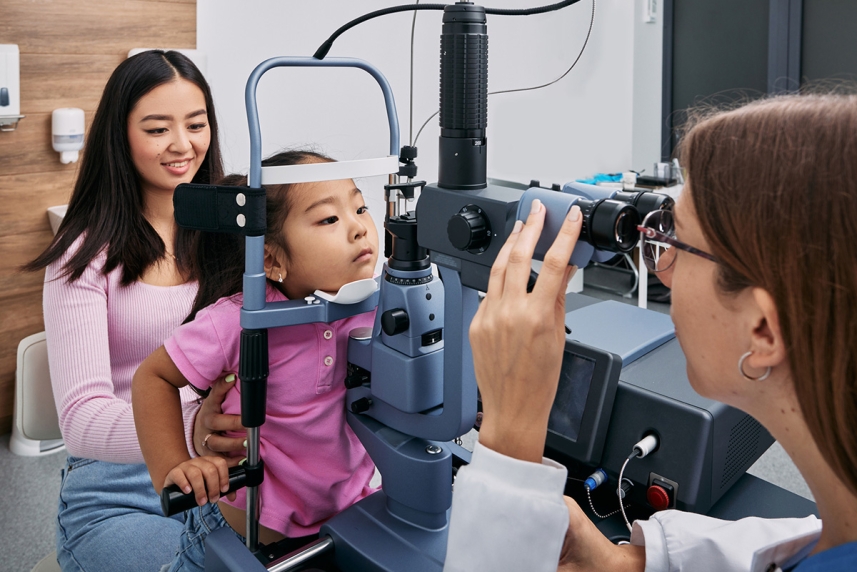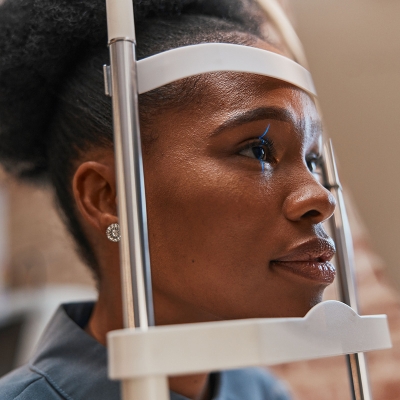4 eye conditions that may affect kids
Here’s how parents could keep an eye out for vision issues in their children — and what treatment might look like.

Many parents may think of vision issues as something that only happens to adults. The truth: Kids may be affected by eye conditions or diseases too.
In fact, almost 7% of children under 18 have been diagnosed with an eye and vision condition, according to the Centers for Disease Control and Prevention.1 That’s why it may be important to have a child’s vision checked as early as possible.
“From infancy, annual eye care is an important part of health care and is as necessary as an annual physical or a trip to the dentist,” says Jacqueline M. Bowen, O.D., an eye care provider in Greeley, Colorado. “Children often don’t know how they should see or feel, so they may not report if something is wrong.”
Sometimes, an eye condition may be obvious: Parents may be able to look at their child’s eyes and see the signs of certain conditions. But they may not always be so obvious.
Learn more about these conditions, including ways to identify symptoms, get kids the right treatment and prevent them whenever possible.
Providers in the UnitedHealthcare Vision Network are here to help keep your vision healthy. Search for an eye care provider now.
Condition #1: Amblyopia (lazy eye)
Lazy eye (amblyopia) happens when there may be issues with how a child’s vision develops. Causes may be due to having a high glasses prescription or structural issues within the eye itself.
Lazy eye may also occur due to other vision obstructing problems, such as cataracts. One eye may go blurry, and the child’s brain may stop using it, with the stronger eye starting to do most of the visual work. The weaker eye may then slip out of position.2
Symptoms of a lazy eye may include:
- Bumping into objects
- Shutting one eye to see better
- Squinting
- Tilting the head to see better
The reasons children may have lazy eye include being born prematurely, having a family history of vision problems or due to other developmental delays. The condition may cause permanent vision issues, so it’s important that a child be treated for it.
Treatment options may range from:2
- Glasses
- Eye drops
- Medication
- Surgery (rarely)
- Wearing an eye patch
Condition #2: Strabismus (crossed eyes)
Crossed eyes (strabismus) may be caused by an alignment problem in a child’s eyes. One eye may drift inwards or outwards, while the other eye may stay focused.3
This condition may be similar to lazy eye, in that the drifting eye may get “ignored” by the brain, potentially leading to permanent vision issues. Crossed eyes may occur because of medical conditions such as:
- Neurological and muscular conditions
- Complications due to premature birth
- Traumatic brain injury (results from a violent blow to the head or body)
Symptoms of crossed eyes may include:
- Eye movements that don’t coordinate
- Having problems perceiving depth
- Seeing double
- Visibly crossed eyes
- Vision in only one eye
Treatment options range from wearing an eye patch and doing strengthening exercises to surgery in some cases.3
Condition #3: Droopy eyelid
A droopy eyelid (ptosis) may occur when a child’s upper eyelid is saggy. The edge of their eyelid may often be lower than it’s supposed to be. Often, a droopy eyelid may happen because of a weak eye muscle or damage to that muscle.4
The condition may start before a child is born, or it may be the result of a condition such as a tumor, diabetes or stroke. Droopy eyelids may also happen due to a condition that’s not serious, such as a stye.4
Symptoms of a droopy eyelid may include:4
- A feeling of vision being blocked in the upper part of the eye
- Decreased vision in the eye with a droopy eyelid
- Eyelid covering the central vision
- Tearing
- Tipping the head back to see
- Tired or aching sensations
A droopy eyelid may be treated by surgery in children, if it’s not caused by a temporary condition such as a stye.4
Condition #4: Cloudy eye
Cloudy eye may be due to cataracts.5 It’s “cloudy,” because it may occur when a child’s eye has a white appearance when a light is shined onto the lens of the eye. Cataracts in children are rare, but they may occur at birth or because of:5
- Diabetes
- Genetic conditions such as Down syndrome
- Injury
Symptoms of a cloudy eye might include:
- Blurry vision
- Cloudy vision
- Eye movements that may be rhythmic and happen on their own
- Misaligned eyes
- Seeing glare
- Seeing halos around lights
- Thinking a light may be too bright
- White pupils
Treatment may include everything from prescription glasses to cataract removal surgery.5
What might a parent do if they think their child may have an eye condition?
If a parent thinks their child may have an eye condition, it’s a good idea to bring them to see an eye care provider. “Traditional vision screenings, such as those offered at schools and pediatrician offices, are a limited process,” explains Dr. Bowen. “They can’t be used to diagnose an eye or vision problem, but rather may indicate a potential need for further evaluation.”
Only an eye care provider may accurately diagnose and determine how serious an eye condition may be. “Something I always tell parents is that most eye misalignment that impacts vision and learning is not visible, even to the pediatrician,” Dr. Bowen continues. “A doctor of optometry is specifically equipped to uncover the more subtle and more common conditions that impact a child’s vision.”
The bottom line: How to protect a child from vision issues may go back to quality vision screenings from the start of a child’s life. “The very early years are the most critical to vision development,” Dr. Bowen says. “During a comprehensive eye exam, the doctor will check for adequate focusing, good eye alignment, healthy eye structures and a long list of other visual skills. Early intervention is key to combat the growing number of children struggling with eye and vision problems.”
Stay on top of your child’s eye health with an in-network provider. Search for an eye care provider now.
Sources:
- Fast facts: vision loss Centers for Disease Control and Prevention, May 2024.
- Lazy eye (amblyopia) Cleveland Clinic, June 2023.
- Strabismus Johns Hopkins Medicine.
- Eyelid drooping Mount Sinai.
- Cataracts in children Stanford University Medicine.


